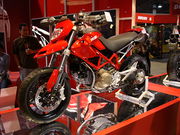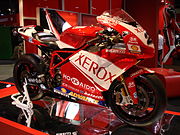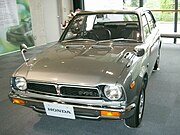
| Ducati Motor Holding, SpA | |
|---|---|
| Type | Public (Borsa Italiana:DMH) |
| Founded | 1926 |
| Founder | Bruno Cavalieri Ducati Adriano Ducati Marcello Ducati |
| Headquarters | |
| Key people | Giampiero Paoli (Chairman) Gabriele Del Torchio (CEO) |
| Industry | motorcycle manufacturer |
| Products | motorcycles |
| Revenue | €304,794,000 (2006) |
| Operating income | €34,715,000 (2006) |
| Net income | -€8,523,000 (2006) |
| Employees | 1,134 (2006) |
| Subsidiaries | Ducati Corse SpA (SuperBike and MotoGP racing) |
| Website | Ducati.com |
| Ducati Motor Holding, SpA | |
|---|---|
| Type | Public (Borsa Italiana:DMH) |
| Founded | 1926 |
| Founder | Bruno Cavalieri Ducati Adriano Ducati Marcello Ducati |
| Headquarters | |
| Key people | Giampiero Paoli (Chairman) Gabriele Del Torchio (CEO) |
| Industry | motorcycle manufacturer |
| Products | motorcycles |
| Revenue | €304,794,000 (2006) |
| Operating income | €34,715,000 (2006) |
| Net income | -€8,523,000 (2006) |
| Employees | 1,134 (2006) |
| Subsidiaries | Ducati Corse SpA (SuperBike and MotoGP racing) |
| Website | Ducati.com |
Ducati Motor Holding (Borsa Italiana:DMH) is an Italian motorcycle manufacturer located in Bologna, Italy.
From their first post-Second World War bicycle-like low-displacement motorbikes Ducati has gained prominence in motorcycle racing and in the motorcycle industry.
In the 1960s, Ducati earned its place in motorcycling history by producing the then fastest 250 cc road bike available, the Mach 1.[1][2] [3] In the 1970s Ducati began producing large-displacement L-twin (i.e. a 90° V-twin) motorcycles and in 1973 released an L-twin with the trademarked desmodromic valve design. In 1985, Cagiva bought Ducati and planned to rebadge Ducati motorcycles with the lesser-known Cagiva name (at least outside of Italy). By the time the purchase was completed, Cagiva kept the "Ducati" name on its motorcycles. In 1996, Texas Pacific Group bought for US$325 million a 51% stake in the company and in 1998, bought the remaining 49% and became the sole owner of Ducati. In 1999, TPG issued an IPO of Ducati stock and renamed the company Ducati Motor Holding SpA. TPG sold over 65% of its shares in Ducati. In December 2005 Ducati returned to Italian ownership with the sale of Texas Pacific's stake (minus one share) to Investindustrial Holdings, the investment fund of Carlo and AndreaCompany history
[edit] Ownership
- (1950 - 1967) Government IRI management years (In 1953 split into Ducati Meccanica, and Ducati Elettronica, now called Ducati Energia SpA)
- (1967 - 78) Government EFIM management (control over day-to-day factory operations)
-
- (1967 - 73) Headed By Montano
- (1973 - 78) Headed by De Eccher
- (1978 - 85) Subsidiary of state-subsidized VM Group
- (1985 - 1996) Cagiva Group ownership
- (1996 - 2005) Texas-Pacific Group ownership and going public
-
- Headed by Federico Minoli, 1996-2001 and returning in 2003
- (2006 - present) Investindustrial: Back in Italian Hands
[edit] Beginnings
In 1926, three brothers Adriano, Marcello and Bruno Ducati founded Societa Scientifica Radio Brevetti Ducati in Bologna. The company produced tubes, condensers and other radio components. The cornerstone of a new factory in Borgo Panigale was laid in 1935. During the war, the factory was a target for Allied bombing. Although badly hit more than once, production was maintained. About this time Aldo Farinelli began working with the small Turinese firm SIATA (Societa Italiana per Applicazioni Tecniche Auto-Aviatorie) with the idea of developing a small engine that could be mounted on a bicycle. The noise of the engine's short stubby exhaust inspired the name "Cucciolo" (Italian: "little puppy"). Barely one month after the official liberation of Italy, SIATA announced their intention to sell Cucciolo engines to the public; it was the first new automotive design to appear in postwar Europe. The first Cucciolos were available only as a motor to be attached by the owner to a normal bicycle. Some businessmen bought the little engines in quantity, installed them in frames and offered these complete units for sale.
By 1950, with 200,000 Cucciolos already sold, Ducati finally offered its own complete motorcycle based on the successful little pushrod engine. The collaboration with SIATA resulted in a well designed little 60 cc bike. This first Ducati motorcycle weighed 98 pounds and had a top speed of 40 mph (64 km/h). Its 15 mm carburetor gave a little under 200 mpg (85 km/L). In the 1950s, Ducati officially dropped the "Cucciolo" name, replacing it with "55M" or "65TL".
The market was moving towards bigger motorcycles though, and Ducati's IRI management felt diversification was the only answer. Ducati made an impression at the early 1952 Milan Show, introducing the Ducati 65 TS cycle and the Cruiser, a four-stroke motor scooter. Despite being described as the most interesting new machine at the 1952 show, the Cruiser was not a great success. A couple thousand were made over a two year period before being withdrawn from production.
In 1953, management decided to split the operation into two separate entities, Ducati Meccanica SpA, and Ducati Elettronica, under separate management. (Ducati Elettronica became Ducati Energia SpA in the eighties.)
Dr. Giuseppe Montano took over as head of Ducati Meccanica SpA and the old Borgo Panigale factory was modernized with government assistance. By 1954, Ducati Meccanica SpA was producing 120 bikes a day, but cheap cars were entering the market, and sales for many motorcycle manufacturers would decline.
From the 1960s to the 1990s the Spanish company MotoTrans licensed Ducati engines and produced motorcycles that were recognizably Ducati derived, although incorporating many subtle differences. MotoTrans' most notable machine was the 250 cc 24 Horas (Spanish: 24 hours), a 285 cc version that won the Barcelona twenty-four hour race at the Montjuic circuit for three consecutive years, 1956 to 1958.
[edit] Motorcycle designs
Ducati is best known for high performance motorcycles characterized by trellis-style frames and large capacity four-stroke, 90-degree L-twin[4] engines featuring a desmodromic valve design.[5] Modern Ducatis remain among the dominant performance motorcycles available today partly because of the Desmodromic valve design, which is nearing its 50th year of use. Desmodromic valves are closed with a separate, dedicated cam lobe and lifter instead of the conventional valve springs used in most internal combustion engines. This allows the cams to have a more radical profile, thus opening and closing the valves more quickly without the risk of valve-float which is likely when using a "passive" closing mechanisms under the same conditions.
While most other manufacturers utilize wet-clutches (with the spinning parts bathed in oil)[6] Ducati uses multiplate dry clutches in many of their current motorcycles. The dry clutch eliminates the power loss from oil viscosity drag on the engine even though the engagement may not be as smooth as the oil bath versions, and the clutch plates can wear more rapidly.
[edit] Product history
The chief designer of Ducati motorcycles from the 1950s was the late Fabio Taglioni (1920-2001). He designed most Ducatis during this period, ranging from the small single cylinder machines that were successful in the Italian 'street races' up to the large capacity twins of the 80s. Ducati introduced the Pantah in 1979; its engine was updated in the 1990s in the Ducati SuperSport (SS) series. All modern Ducati engines are derivatives of the Pantah, which uses a toothed belt to actuate the engine's valves. Taglioni used the prancing horse (identified with the Ferrari brand) on his Ducati motorbikes, Taglioni chose this emblem of courage and daring as a sign of respect and admiration for Francesco Baracca, a heroic World War I fighter pilot that died during an air raid in 1918[7] [8]
[edit] 1950s
[edit] 1960s
[edit] 1970s
In 1973, Ducati also commemorated its 1972 win at the Imola 200 with the production model green frame Ducati 750 SuperSport.
(In 2006 the retro styled Ducati PaulSmart1000LE, which shares styling cues with the 1973 750 SuperSport (itself a production replica of Paul Smart's 1972 race winning 750 Imola Desmo ) was released, as one of a SportClassic series representing the 750 GT, 750 Sport, and 750 SuperSport Ducati motorcycles.)
[edit] 1980s
Ducati's liquid-cooled multi-valve V twins made from 1985 on are known as Quattrovalvole ("four-valve"). These include the 916 and 996, 999 and a few predecessors and derivatives.
[edit] 1990s
In 1993, Miguel Angel Galuzzi introduced the Ducati Monster[9] , a naked bike with exposed trellis and engine. Today the Monster accounts for almost half of the company's worldwide sales. The Monster, which has been out since 1994, has undergone the most changes of any motorcycle that Ducati has ever produced. After more than a decade of manufacturing, Ducati continues to create innovative changes to this classic motorcycle.
In 1995, the company introduced the Ducati 916 model designed by Massimo Tamburini, a water-cooled version that allowed for higher output levels and a striking new bodywork that featured aggressive lines, underseat exhausts, and a single-sided swingarm. Ducati has since ceased production of what many called the bike of the 1990s, supplanting it with the 749 and 999.
[edit] Current lineup

For the 2007 model year, Ducati introduces several new bikes including the 1098, Monster 695, S4R, and Hypermotard.
- 695
- S2R 800
- S2R 1000
- S4R Testastretta
- S4R S Testastretta
- 1100
- 1100 S
- GT 1000
- Sport 1000 monoposto
- Sport 1000 biposto
- Sport 1000 S biposto
- Sporttouring
- ST3
- ST3 S ABS
- Superbike
- 1098
- 1098 S
- 1098 S Tricolore
- Other
- Motors used in 2006
- Desmodue: Desmo two valve air cooled, 40° included valve angle, (800SS, Multistrada 620, Monster 620 695 803 992)
- Desmodue Double Spark: Desmo two valve , air cooled, 40° included valve angle, (1000DS, Multistrada 1000DS)
- Desmotre Double Spark: Desmo three valve, liquid cooled, 40° included valve angle, (ST3)
- Desmoquattro Testastretta: Desmo four valve, liquid cooled, 25° included valve angle, (999, 749, Monster S4RS)
- Motors introduced for 2007
- Testastretta Evoluzione: Desmo four valve, liquid cooled, 25° included valve angle, (1098)
[edit] Future
Ducati had completed testing the Desmosedici GP7, Ducati's 2007 MotoGP race bike. The GP7 complies with new regulations requiring a maximum of 800 cc (as compared with the 989 cc of the GP6). The GP7 is currently known to be the most powerful 800 cc MotoGP race bike, as illustrated in the 2007 Qatar GP, where the four Ducatis produced, by a considerable margin, the highest top speeds of the entire MotoGP grid.
[edit] Motorcycle design history
Ducati (in its various incarnations) has produced several styles of motorcycle engines, including varying the number of cylinders, type of valve actuation and fuel delivery. Ducati is best known for its "L-Twin" motor which is the powerplant in the majority of Ducati-marqued motorcycles. Ducati has also manufactured engines with one, two, three or four cylinders; operated by pull rod valves and push rod valves; single, double and triple overhead camshafts; two stroke and even at one stage manufactured a stationary diesel engine, many of which were used as emergency pumps (eg for fire fighting). Currently, Ducati makes no other engines except for its motorcycles.
On current Ducati motors, the valves are actuated by a standard valve cam shaft which is rotated by a timing belt driven by the motor directly. The teeth on the belt keep the camshaft drive pulleys indexed. On older Ducati motors, prior to 1981, drive was by solid shaft that transferred to the camshaft through bevel-cut gears. This method of valve actuation was used on many of Ducati's older single cylinder motorcycles - the shaft tube is visible on the outside of the cylinder.
Ducati is also famous for using the desmodromic valve system championed by engineer and designer Fabio Taglioni though they have also used engines that use valve springs to close their valves. In the early days, Ducati reserved the desmodromic valve heads for its higher performance bikes and its race bikes. These valves do not suffer from valve float at high engine speeds, thus a desmodromic engine is capable of far higher revolutions than a similarly configured engine with traditional spring-valve heads.
In the 1960s and -70s Ducati produced a wide range of small two-stroke bikes, mainly sub-100 cc capacities. Large quantities of some models were exported to the U.S.
Ducati has produced the following engine types:
- Single cylinder,
- bevel actuated, spring valved: 98 cc, 160 cc, 175 cc, 200 cc, 250 cc, 350 cc, 450 cc
- bevel actuated, desmodromic valved: 250 cc, 350 cc and 450 cc
- Two cylinder,
- bevel actuated, spring valved (L-Twin): 750 cc, 860 cc
- bevel actuated, desmo valved (L-Twin): 750 cc, 860 cc
- chain actuated, spring valved (parallel twin): 350 cc, 500 cc (GTL)
- chain actuated, desmo valved (parallel twin): 500 cc (500SD)
- belt actuated, desmo valved (L-Twin): Almost all motors since 1986.
- Four cylinder,
- gear actuated, desmo valved (L-quattro): (Desmosedici)
- bevel actuated, spring valved (L-4): Prototype Apollo, only two made.
[edit] Ducati products other than motorcycles
Ducati Meccanica (as the company was previously known) has its marque on non-motorcycle products as well. In the 1930s and 40s, Ducati manufactured radios, cameras, and electrical products such as a razor. The Ducati Sogno was a half-frame Leica-like camera which is now a very rare collectors' item.
Currently, there are four Ducati companies: Ducati Motor Holding (the subject of this article), Ducati Corse (which runs the Ducati racing program), Ducati Energia, a designer and manufacturer of electrical and electronic components and systems and Ducati Sistemi, a subsidiary of Ducati Energia. All are located in Borgo Panigale in Bologna, Italy.
Ducati Motor Holding often uses electrical components and subsystems from Ducati Energia.
[edit] Racing History


[edit] MotoGP
Ducati rejoined Grand Prix motorcycle racing in 2003, after a 30 year absence.[10] Loris Capirossi has been with the team since its current inception in 2003 and Casey Stoner joined him as a teammate for the 2007 season riding the Desmosedici GP7. On September 23, 2007 Casey Stoner clinched his and Ducati's first Grand Prix World Championship.
When Ducati re-joined MotoGP in 2003, MotoGP had changed its rules to allow four-stroke 900cc engines to race. At the time Ducati was the fastest bike. In 2007, MotoGP reduced the engine size to 800cc, yet Ducati continued to be the fastest bike. Ducati continued that trend in 2007 with a bike that was markedly faster than its rivals as was displayed by Casey Stoner on tracks with long straights.
Ducati also supplies bikes to the Pramac d'Antín team, who are running the Desmosedici GP7.
For the 2008 MotoGP season, Ducati will campaign their Desmosedici GP8 with Casey Stoner and Marco Melandri.[11] On 16 August 2007, Suzuki announced that Capirossi would ride with them in 2008, alongside Australian Chris Vermeulen.[12]
| Year | Country | Champion | Bike |
|---|---|---|---|
| 2007 | Casey Stoner | Ducati GP7 |
[edit] World Superbike Rider Championships
Ducati currently campaigns their 999F07 in the series, which is a homologated racing version of the 999R. For the 2008 season, Ducati will race a homologated version of their current 1098. The reason for this is that currently, the FIM, the sanctioning body for the Superbike World Championship, limits the maximum displacement for a 2 cylinder motor (which is the type of engine Ducati uses in their 999 and 1098 bikes) to 1,000 cc. For 2008, the FIM has raised the displacement limit for a 2 cylinder motor to 1,200cc.[13]
The company has enjoyed twelve Superbike World Championships since the series' inception in 1988.
| Year | Country | Champion | Bike |
|---|---|---|---|
| 1990 | Raymond Roche | Ducati 851 | |
| 1991 | Doug Polen | Ducati 888 | |
| 1992 | Doug Polen | Ducati 888 | |
| 1994 | Carl Fogarty | Ducati 916 | |
| 1995 | Carl Fogarty | Ducati 916 | |
| 1996 | Troy Corser | Ducati 916 | |
| 1998 | Carl Fogarty | Ducati 996 | |
| 1999 | Carl Fogarty | Ducati 996 | |
| 2001 | Troy Bayliss | Ducati 996 | |
| 2003 | Neil Hodgson | Ducati 999 | |
| 2004 | James Toseland | Ducati 999 | |
| 2006 | Troy Bayliss | Ducati 999 |
Ducati has also won thirteen WSBK Manufacturer Championships for years 1991–1996, 1998, 1999, 2001–2004, and 2006.
[edit] AMA Superbike
In the AMA Superbike series, Ducati has had its share of success, with Doug Polen winning the title in 1993 and Troy Corser the following year in 1994. Ducati has entered a bike in every AMA Superbike season since 1986, but withdrew from the series after the 2006 season.[14][15][16]
[edit] British Superbike
The British Superbike series has been won by Ducati riders on seven occasions: 1995 Steve Hislop, Scotland; 1999 Troy Bayliss, Australia; 2000 Neil Hodgson, England; 2001 John Reynolds, England; 2002 Steve Hislop, Scotland; 2003 Shane Byrne, England; 2005 Gregorio Lavilla, Spain














